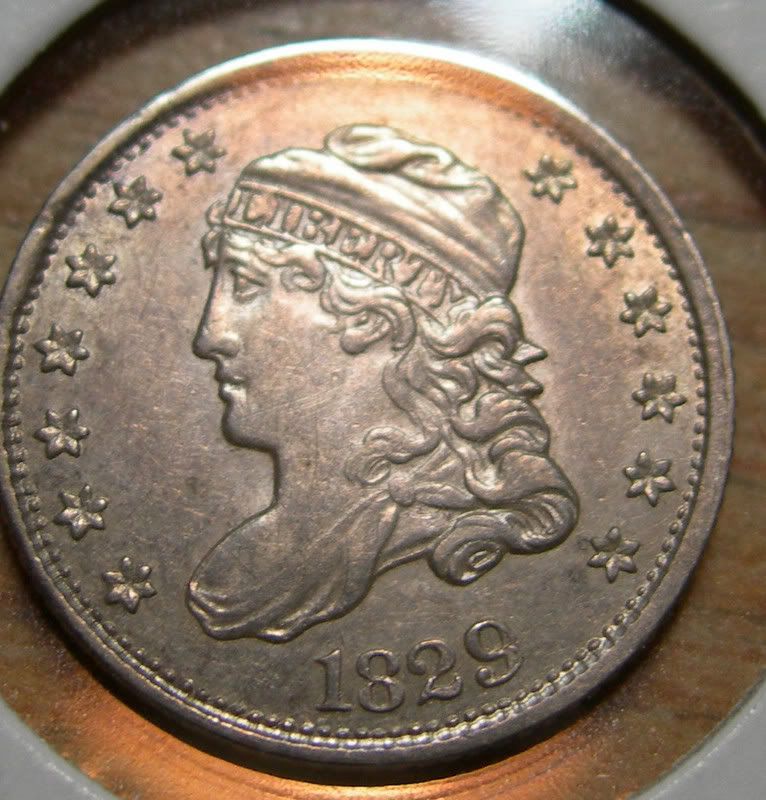Options
Half dime experts can you help me with this coin?
The coin in question is a 1829 half dime that I think is a 9 over 3 overdate. In the Cherrypickers' guide it is listed as a URS-2 I-5 L-5. Any more information will be helpful. Thank you
John


John


0
Comments
K S
Thank you.
It looks like a pretty coin with nice details. Congrats.
NSDR - Life Member
SSDC - Life Member
ANA - Pay As I Go Member
This same obverse die was used in three die marriages for the year 1829, the LM-3, LM-4, and LM-9, which are R2, R3, and R5, respectively. (The LM numbers chronologically designate the emission order, or order of manufacture; LM-9 was minted after LM-4, which was minted after LM-3). The other die marriages (LM-4, LM-9) pair this obverse die with different reverse dies.
This die marriage paired obverse die 3 with reverse die C, which is an example of the three pale gules reverse, meaning that there are three vertical lines in each stripe on the reverse shield. This was done to make the half dimes similar in appearance to the larger silver denominations, but was quickly abandoned after it was determined that the half dime was simply too small to provide that much detail; the vertical stripes would not strike up well, and are often seen blended together. The design was modified to include two pale gules early in 1829.
Like many other half dime specialists, I am disturbed that the authors of the Cherrypicker's Guide chose to designate this obverse as an 'overdate', acting almost in a vacuum, without consultation with half dime specialists who could have provided additional insight. Had they consulted with Russell Logan or John McCloskey, or other half dime specialists, they would have learned that this is not an overdate, with the 9 punched over a 3, as listed in the Cherrypicker's Guide, but rather is simply a repunched 9, with the ball of the 9 strongly doubled. Close inspection of this obverse die, under a stereo microscope, reveals that the numeral 9 digit was simply repunched by the die sink to strengthen it, a rather common occurence considering that all of the numerals and letters were individually punched into each working die for this series. In proper numismatic terminology, this is what is called a 'repunched date', wherein the repunched numeral is the same numeral as the first, as opposed to an 'overdate', wherein the repunched numeral is a different numeral from the first. Indeed, there are no overdates in the entire Capped Bust half dime series.
Since publication of the latest edition of the Cherrypicker's Guide, where this presumed 'overdate' was first listed, and its supposed (although grossly misrepresented) rarity was published, many dealers have attached a premium to this 'variety', which it truly does not deserve. It is just an R2 die marriage. In my own collection I have three examples of the LM-3 (AU-58, EF-45, EF-45), two examples of the LM-4 (AU-58, AU-50), and two examples of the LM-9 (AU-53, VG-10) (I have owned nine examples of this R5 marriage). None of these are an overdate, none exhibit a 9 over 3, and none deserve a premium for the repunched numeral. Rather than pay a large and undeserved premium for this misrepresented 'overdate', simply spend some time on any bourse floor and locate an unattributed example of this very common die marriage for a generic price.
There is a rare die state (R7+) of the 1829 LM-3/V2 which exhibits a large full cud over IT of UNITED on the reverse. I own the ex: Reiver specimen, a nice EF-45 (NGC AU-53) which may be seen here:
http://coins.ha.com/common/view_item.php?hdnJumpToLot=1&Sale_No=390&Lot_No=21961
From your photograph it does not appear that your coin is the terminal die state, with the cud.
I hope this provides some insight into your half dime.
John